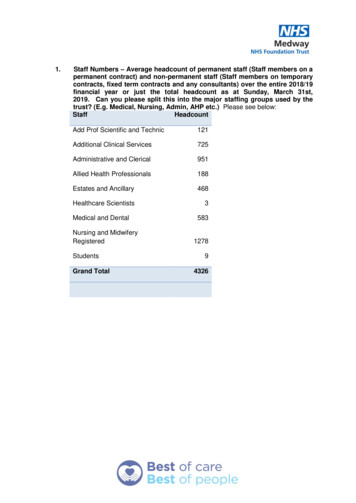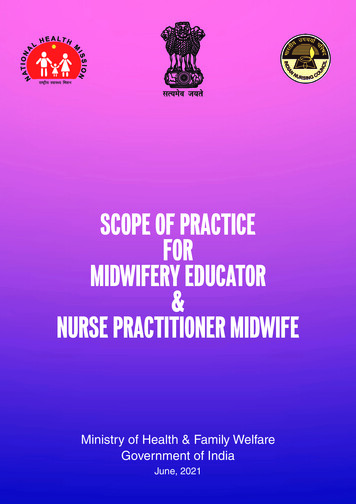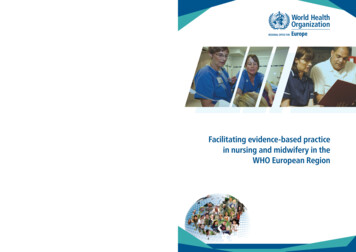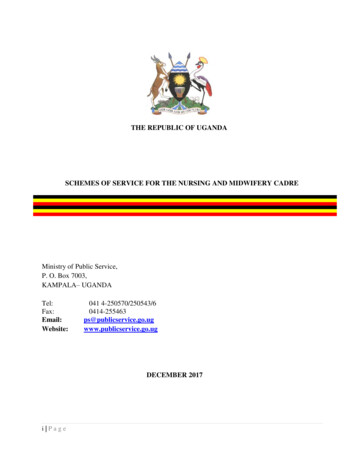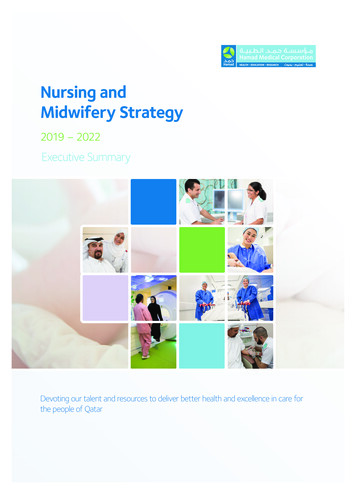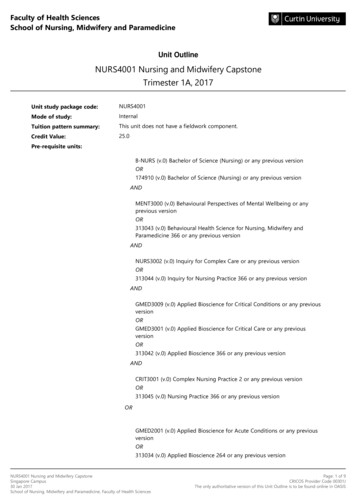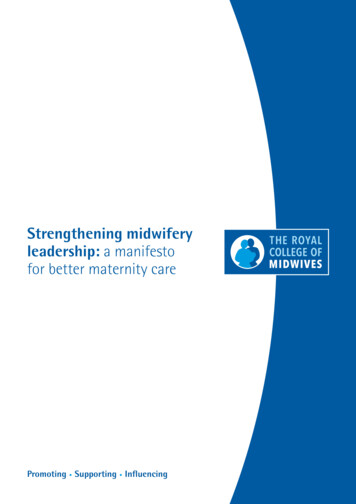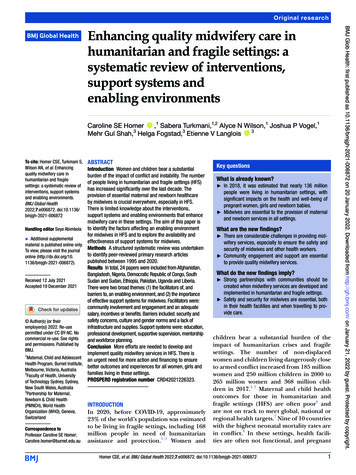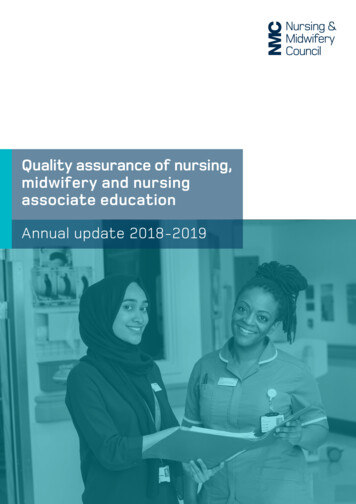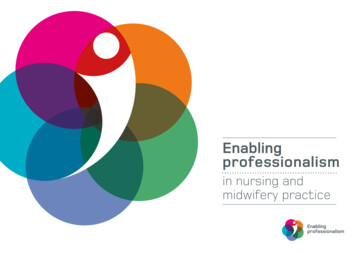
Transcription
Enablingprofessionalismin nursing andmidwifery practice
Enabling professionalism in nursing and midwifery practice Professionalism means something to everyone whoworks as a nurse or midwife. Being an inspiring rolemodel working in the best interests of people in yourcare, regardless of what position you hold and whereyou deliver care, is what really brings practice andbehaviour together in harmony.Enabling professionalism innursing and midwifery practicedescribes and demonstrates whatprofessionalism looks like in everydaypractice through the applicationof the Code. This will help you asa nurse or midwife to think aboutyour contribution to the service youprovide and demonstrate evidencefor revalidation.There are also responsibilitiesfor those who employ nursesand midwives to ensure theirpractice environments support andencourage professional behaviours.Enabling professionalism alsoidentifies employer principles forproviding practice environments thatsupport and encourage professionalbehaviours and appropriate challenge.1
Enabling professionalism in nursing and midwifery practice IntroductionGood health and care outcomes are highlydependent on the professional practice andbehaviours of nurses and midwives.Nurses and midwives play a criticalrole in strategy, service redesign andimproving health outcomes, activelyenabling co-production and decisionmaking at all levels of policy makingand service provision. There is astrong evidence base to demonstratethe effectiveness of nurse andmidwife led services.1234The nursing and midwiferyprofessions want to facilitatechange and improve outcomesfor people. They have the clinicalinnovation to help meet thechallenges facing the NHS and thosethey serve. Nurses and midwiveswant to celebrate good practice,support improving practice andchallenge poor practice to uphold thestandards of the professions for thegood of the public. These changesare being realised without diminishingthe importance of the fundamentalsof care and indeed highlight theimportance of compassion and caringas central to the distinct roles ofevery nurse and midwife.In March 2015 the Nursing andMidwifery Council (NMC), theregulator for nurses and midwives,published and implemented theCode: Professional standards ofpractice and behaviour for nursesand midwives.5 The Code providesthe professional standards to whichnurses and midwives practice, andso it requires consideration by policymakers in order to maximise thecontribution of nurses and midwives.There are 688,927 nurses andmidwives currently registered withthe NMC, all of whom will use theCode to revalidate over the nextthree years. While revalidation isultimately the responsibility ofthe individual nurse or midwife,employers have an important roleto play in ensuring that nursesand midwives are prepared forthe new process and work withinsupportive environments.Promoting the Code in practiceis essential, to enable nurses andmidwives to lead and support goodquality care, implement change andapply sound professional judgement,supported by environments thatenable professional behaviours. Beingthe largest workforce provides theopportunity to enhance strongclinical leadership and to deliveror support others to deliver highquality care and services to thepeople of the UK.Enabling professionalism in nursingand midwifery practice will be ofinterest to the entire spectrum ofstakeholders at political, strategic,operational, practitioner and publiclevels across the health and socialcare system in the UK.This framework aims to promoteprofessionalism in nursing andmidwifery through focusing onthe Code and how it is used inrevalidation but the key messagesshould be understood andmeaningful to all.Enabling professionalism for thecontext of nursing and midwifery ispresented within the following keyelements: Definition of what professionalismis, and its purpose Description of attributes thatdemonstrate professionalism Description of organisational andenvironmental factors to supportand enable professional practiceand behaviours Description of individualresponsibilities to support andenable professional practice andbehavioursEnabling professionalism will: provide a foundation for andstrengthen the leadership rolethat nurses and midwives will havein future changes across all areaswhere registrants practice assist nurses and midwives toarticulate their effectiveness,demonstrate accountability andmeet revalidation requirementsThe Code provide practical examples ofwhat the public can expectfrom a nurse or midwifewherever and whenever theycome into contact with them.2
Enabling professionalism in nursing and midwifery practice What is professionalism?Professionalism is characterised by the autonomousevidence-based decision making by members of anoccupation who share the same values and education.Professionalism in nursing and midwifery is realisedthrough purposeful relationships and underpinned byenvironments that facilitate professional practice.Professional nurses and midwives demonstrate andembrace accountability for their actions.The purpose ofprofessionalism in nursingand midwiferyThe ultimate purpose ofprofessionalism in nursing andmidwifery is to ensure the consistentprovision of safe, effective, personcentred outcomes that supportpeople and their families and carers,to achieve an optimal status of healthand well-being.Maintaining professionalismRegistered nurses and midwives practising at graduatelevel are prepared with the behaviours, knowledge andskills required to provide safe, effective, person-centredcare and services. They are professionally socialisedto practise in a compassionate, inter-professionaland collaborative manner. This is recognised throughcontinuing a registered nurse or midwife status with theNMC. Practice and behaviour are underpinned by the Code5and demonstrated through a number of attributes or prerequisites of nursing and midwifery practice, namely:The achievement of this aim can bedemonstrated through:Being Accountable[Practiseeffectively] Consistent outcomes of careand services Effective care that enables peopleto have the best health status andquality of life they can achieve Care settings that enable nursesand midwives to flourish People describing goodexperiences of care and services Individualised care and servicesevidenced through support forpersonal choices and increasedinvolvement in decision makingabout planned care or services Better use of resources Improved health outcomesfor populationsProblem solvingAble to challengeReflectiveEvidence basedBeing an advocate[Prioritise people] Emotionally competentResilientImpartialCompassionateBeing a leader[Promoteprofessionalismand trust] AutonomousA coordinatorHonestInnovativeSystem thinkingBeing competent[Preserve safety] Technically competent Critically thinking Inquiring3
Enabling professionalism in nursing and midwifery practice Enabling professionalismWhether in community, hospital, social care, education orone of many other settings, the environments6 in whichnurses and midwives work are pivotal in supportingprofessional practice and behaviours.This includes fostering a positive environment to raise concerns when issuesarise that could compromise safety, quality and experience. An environmentthat supports and enables professional practice and behaviours is one that:Recognises and encourages nursingand midwifery leadership through:Enables positive inter-professionalcollaboration through: Partnership approaches to team working Clear lines of accountability Inter-professional learning/team working opportunitiesEnables practicelearning anddevelopment through: Valuing the evidence-based opinion of nursesand midwives Pre-registration programmesthat develop professionalismand resilience Nurses and midwives occupying roles ofleadership and influence across systems Regular supervision and a focuson reflective practice Shared governance and decision making Organisational risk assessment that acceptsprofessional judgement as a basis for action Provision of professionaldevelopment opportunities andmeaningful appraisalEncourages autonomousinnovative nursing and midwiferypractice through:Provides appropriateresources throughaccess to appropriate: Policies that support critical thinking inpractice and decision making Staffing - including experienceand skill mix Flexibility to develop appropriate new roles Funding for learning anddevelopment Enabling practitioners to operate withinthe upper limits of scope of practice Providing access to expertise to supportcoaching models and practice learning Equipment including informationtechnology devices and software Shared information and data4
Enabling professionalism in nursing and midwifery practice Upholding individualprofessionalismIn addition to the environmental considerations that canhave an impact on the ability of a nurse or midwife to actprofessionally, the individual practitioner is responsible forupholding his or her own professional practice through:Learning and developingcontinuously by:Being a role model forothers by: Making the most of opportunitiesthrough revalidation via existingsupervision and appraisal systems Demonstrating and articulatingclearly what professionalism lookslike in practice Demonstrating positive behavioursand attitudes towards diversity Working within a clear professionalcareer framework Supporting colleagues and students Celebrating personal success andthat of others Developing people to take on seniorroles and supporting those insenior roles Treating others with a positive regard Providing meaningful andconstructive feedback to others Access to necessary resources tosupport professional development Promoting a learning culture forothersEnabling person-centredand evidence-informedpractice by: Incorporating up-to-date evidencein daily practiceSupporting appropriateservice and careenvironments by: Sharing and disseminatingevidence-informed practice Participation in the generationof new evidence and workinginnovatively Raising concerns when issues arisethat could compromise safety,quality and experience Lobbying for change andimprovement Supporting others to raiseconcerns appropriatelyLeading professionally by: Defining and understanding clearreferral pathways to supportstandards of professional practice Seeking connection to and supportfrom professional bodies andorganisations Delegate tasks and duties safely Developing self to lead strategically Identifying appropriateprofessional support networks forself and others Developing others to leadstrategically Working collegiately with otherprofessions Supporting those in leadership5
Enabling professionalism in nursing and midwifery practice About EnablingprofessionalismEnabling professionalism was produced under the commission of the fourChief Nursing Officers (CNOs) and supported by the Nursing and MidwiferyCouncil. The work brought together nursing and midwifery leaders across alllevels of practice to draw on their experience and knowledge of nursing andmidwifery professionalism. Working forward from the considerable evidenceon the subject and significant regional work across the four countries, theProject Board, under the chairmanship of Professor Charlotte McArdleCNO for Northern Ireland, supported by the Northern Ireland Practice andEducation Council for Nursing and Midwifery (NIPEC), brought together abroad framework which was tested and further developed with care andservice environments for utility.Partners within the Project Board comprised representatives of thefour CNOs, colleagues at the NMC, policy level, service and educationproviders, service users, independent and voluntary sectors, staff-side andprofessional organisations.1. Leary, A. and Oliver, S. (2010). Clinical Nurse Specialists: Adding Value to Care. London, RoyalCollege of Nursing.2. Schadewaldt, V. and Schultz, T. (2010). A systematic review on the effectiveness of nurse-ledcardiac clinics for adult patients with coronary heart disease. Available for download at:http://www. ir/article/view/100. Accessed8th March 20163. Sandall J, Coxon K, Mackintosh N, Rayment-Jones H, Locock L, Page L (2016) Relationships:the pathway to safe, high-quality maternity care. Report from the Sheila Kitzingersymposium at Green Templeton College, October 2015. www.gtc.ox.ac.uk/images/stories/academic/skp report.pdf4. Sandall J, Soltani H, Gates S, Shennan A, Devane D. (2016). Midwife-led continuity models versusother models of care for childbearing women. Cochrane Database of Systematic Reviews 2016,Issue 4. Art. No.: CD004667. DOI: ow.ly/UDIS300BKPj5. Nursing and Midwifery Council. (2015). The Code: Professional standards of practice andbehaviour for nurses and midwives. London, NMC.6. It is recognised that nurses and midwives work in a range of environments in organisations.It is the organisations that, in many cases, are responsible for systems and processes thatenable professional practice, rather than individual practice areas.6
www.nmc.org.uk/professionalism
Enabling professionalism in nursing and midwifery practice 2 Nurses and midwives play a critical role in strategy, service redesign and improving health outcomes, actively enabling co-production and decision making at all levels of policy making and service provision. There is a strong evidence base to demonstrate the effectiveness of nurse and
